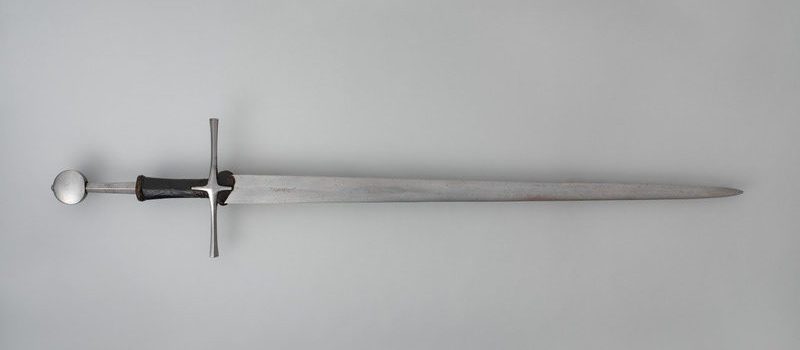Hand and a Half Sword Vs. Longsword: Unveiling the Differences
NO AI USED This Article has been written and edited by our team with no help of the AI

The hand-and-a-half sword and longsword are iconic double-edged blades used throughout medieval European battles. Their modern terms are largely based on their distinct combat applications, yet they share many traits that make them hard to distinguish from one another. Closer inspection will reveal notable differences in design, utility, and history.
In this article, we will compare the hand-and-a-half sword and the longsword. We will shed light on their modern terms and then delve into the biggest differences in their characteristics and design. We will explore how they were used for various combat scenarios and their historical significance.
Characteristics and Design Differences

The longsword and hand-and-a-half, or bastard swords, are European medieval swords with double-edged blades. They have similar styles of cruciform crossguards, and their blades feature identical blade profiles, cross-sections, fullers, and tips based on their intended purpose in battle.
While both swords hail from the medieval era, they are not the same. The term longsword is related to the German langschwert, meaning a larger contemporary shortsword such as the arming sword, better known as the knightly sword.
The hand-and-a-half sword is larger than the arming sword, technically making it a longsword. It is otherwise known as a bastard sword, and while its origin is disputed, it is likely linked with the French épée bâtarde. It shares a peculiar mixed unique style with traits both of one-handed and two-handed blades.
Today, the term longsword does not refer to the hand-and-a-half variant but to the two-handed hilted version with a larger blade. The biggest difference that sets them apart is their designs, traits, the lengths of their blades, and the forms of their hilts and handles.
Blade

True to its name, the longsword generally features a much longer blade, with some styles ranging from blade lengths up to 47 inches (120 cm). The blade of this type of sword is heavily tapered with a diverse design. But in most cases, it is intentionally crafted to exploit the vulnerabilities and gaps of plate armor and to be easily half-sworded with a second hand.




Hand-and-a-half swords feature a shorter blade design. While being smaller, it can directly mimic the longsword’s tapering blade, while some early hand-and-a-half swords with a broader tip can be made strictly for cutting and slashing purposes. These early styles of swords are sometimes mistakenly called broadswords, a name reserved for 16th-century basket-hilted swords.
Hilt

The hilt of the longsword ranges from 8 to 14 inches (20-35 cm) long. It can be used with a single hand but is unmistakably made for dual-handed use. The handle can be straight but also features a central ridge for enhancing grip and maneuverability. The pommel can be large in design and can be used for bashing and balancing the weight of the blade near the hilt.
Hand-and-a-half swords can have the same hilt length with a long grip but a shorter blade or hilt. Its hilt is made to be compatible with one or two hands. Its handle can feature a central ridge similar to the longsword’s or have the distinct design of a waisted or bottle-shaped lower half with a light taper toward a graspable pommel.
Historical Use and Combat Preference

The hand-and-a-half sword and longsword were used during the Middle Ages. The hand-and-a-half or bastard sword first emerged during the 13th and 14th centuries, primarily as a chopping tool to combat chainmail and early plate armor more effectively than single-handed swords. As noted in the typology of historian Ewart Oakeshott, the weapon gradually evolved into a large sword around the 15th century. The hand-and-a-half sword was now a versatile two-handed weapon capable of defense against armored and unarmored opponents.
The larger hilt of the longsword makes it functional with the hands set apart from each other, while the hand-and-a-half hilt generally has the hands close or touching. This hilt design makes the longsword a dedicated two-handed sword, whereas the hand-and-a-half is a one-handed sword with the added capacity of a secondary grip.
Hand-and-a-Half vs. Longsword in Battle
The longsword and hand-and-a-half swords are the most popular blades used in HEMA (historical European martial arts) training today because they offer more versatility than most European blades, ranging from a cutting Viking sword to a thrusting Renaissance rapier blade.
They are both superb weapons that excel in adaptability and feature a plethora of different designs for unique combat situations. However, in our opinion, when placed against each other in a duel without rules, armor, or shields, the longsword would be the victor.
The length and reach advantage of the longsword would be a huge factor in defeating the shorter hand-and-a-half blade. The added maneuverability of the larger handle allows for them to move freely, giving the wielder momentum for different options of attack and defense, such as countering, thrusting, and slashing. The hand-and-a-half bastard sword may be better for a tight, compact situation in conjunction with a shield or buckler. However, in some cases, the design is too small for two-handed use but too big for one-handed use.





